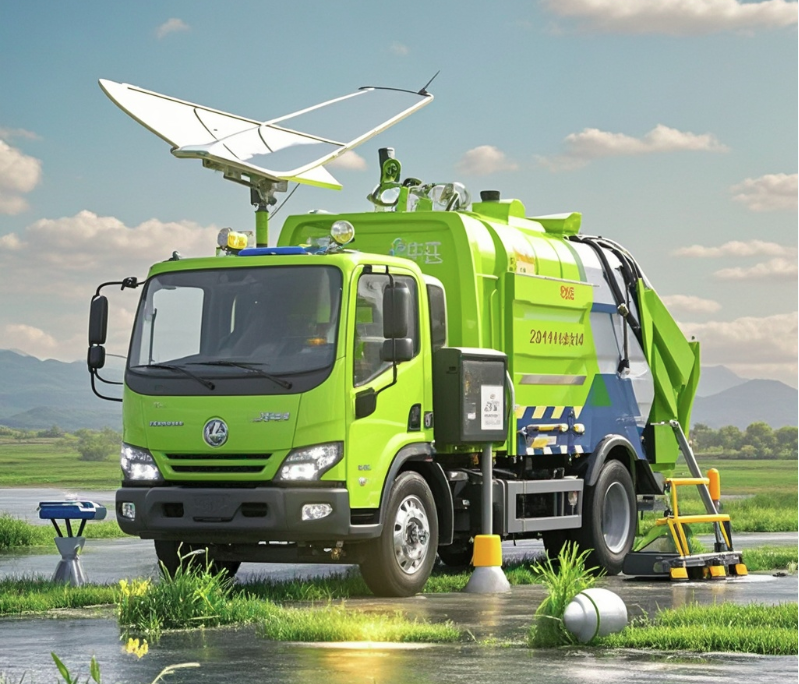Making Wireless IoT Project Easy, Smart, Secure.
GET A FREE SAMPLEWith the development of cities and the continuous improvement of people's requirements for environmental sanitation, efficient management of environmental sanitation operations has become crucial. This plan aims to utilize GPS positioning technology to equip sanitation vehicles with advanced positioning systems, in order to achieve precise monitoring, scientific scheduling, and efficient management of sanitation vehicles, improve the quality and efficiency of sanitation operations, and create a cleaner and more comfortable environment for the city.

System architecture
1. GPS positioning terminal
Installed on each sanitation vehicle, it receives real-time GPS satellite signals and accurately obtains information such as the vehicle's position, speed, and direction of travel. Equipped with data transmission function, vehicle information can be sent to the management platform through wireless network.
2. Communication Network
Using stable and reliable mobile networks or dedicated wireless networks to ensure timely and accurate transmission of positioning data.
3. Management Platform
Composed of servers and management software, it receives vehicle information from GPS positioning terminals and stores, processes, and analyzes it. Provide an intuitive map interface that displays vehicle location, trajectory, work status, etc., facilitating real-time monitoring and scheduling by management personnel.
Main functions
1. Real time positioning and tracking
Management personnel can view the real-time location of sanitation vehicles and understand their driving dynamics at any time on the management platform. By tracking the trajectory of the vehicle, one can grasp the operation route and range of the vehicle, ensuring comprehensive coverage of the operation.
2. Scheduling management
Reasonably arrange the vehicle's work route and task allocation based on the homework tasks and vehicle location. In case of emergency or sudden events, nearby sanitation vehicles can be quickly dispatched for handling.
3. Homework assessment
Record the vehicle's operation time, mileage, and other data as the basis for operation assessment. Evaluate the efficiency and quality of vehicle operations, and motivate drivers to improve their work enthusiasm and sense of responsibility.
4. Security management
Monitor the driving speed of vehicles, remind and record vehicles that exceed the speed limit. When a vehicle malfunctions or accidents occur, promptly obtain location information and initiate rescue procedures.
5. Data analysis and report generation
Perform statistical analysis on vehicle operation data to provide data support for management decisions. Generate various reports, such as job progress reports, fuel consumption reports, maintenance reports, etc., to facilitate management personnel to understand the operation status of vehicles.
Implementation steps
1. Requirement analysis
Have in-depth communication with the environmental sanitation department to understand their management needs and operational processes, and determine the functional requirements and technical indicators of the system.
2. Equipment selection and installation
Select GPS positioning terminals and communication devices with stable performance and powerful functions, and install and debug them. Ensure compatibility and reliability between equipment and sanitation vehicles.
3. Construction of management platform
Build a management platform, install management software, and perform system configuration and testing. Ensure the stability and security of the management platform.
4. Personnel training
Provide system operation training to management personnel and drivers to familiarize them with the system's functions and usage methods. Improve the operational skills and management level of personnel.
5. System trial operation and optimization
Conduct system trial operation, collect user feedback, optimize and improve the system. Ensure the stability and reliability of the system.
Benefit analysis
1. Improve homework efficiency
By scientifically scheduling and reasonably arranging work tasks, reducing vehicle idle time and improving work efficiency. Shorten the garbage collection cycle and improve the level of urban environmental sanitation.
2. Reduce operating costs
Optimize the homework route, reduce vehicle fuel consumption and maintenance costs. Improve vehicle utilization and reduce equipment investment.
3. Improve management level
Realize real-time monitoring and management of sanitation vehicles, and improve the scientific and accurate management. Provide data support for management decision-making, improve management efficiency and level.
4. Enhance emergency response capability
In the event of an emergency, it is possible to quickly dispatch sanitation vehicles for handling and improve emergency response capabilities. Ensure urban environmental sanitation and public safety.
The GPS positioning solution for sanitation vehicles will provide an efficient and scientific management tool for the sanitation department, which will help improve the quality and efficiency of sanitation operations, reduce operating costs, and make greater contributions to the urban environmental sanitation cause.
Copyrights© Shenzhen Skylab Co.,LTD All Rights Reserved.

